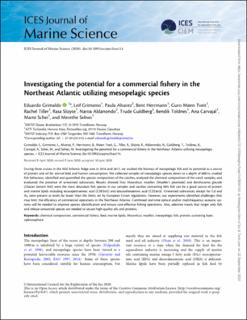| dc.contributor.author | Grimaldo, Eduardo | |
| dc.contributor.author | Grimsmo, Leif | |
| dc.contributor.author | Álvarez, Paula | |
| dc.contributor.author | Herrmann, Bent | |
| dc.contributor.author | Tveit, Guro Møen | |
| dc.contributor.author | Tiller, Rachel | |
| dc.contributor.author | Slizyte, Rasa | |
| dc.contributor.author | Aldonondo, Naroa | |
| dc.contributor.author | Guldberg, Trude | |
| dc.contributor.author | Toldnes, Bendik | |
| dc.contributor.author | Carvajal, Ana Karina | |
| dc.contributor.author | Schei, Marte | |
| dc.contributor.author | Selnes, Merethe | |
| dc.date.accessioned | 2020-10-28T10:16:31Z | |
| dc.date.available | 2020-10-28T10:16:31Z | |
| dc.date.created | 2020-08-24T13:33:13Z | |
| dc.date.issued | 2020 | |
| dc.identifier.citation | ICES Journal of Marine Science. 2020, . | en_US |
| dc.identifier.issn | 1054-3139 | |
| dc.identifier.uri | https://hdl.handle.net/11250/2685454 | |
| dc.description.abstract | During three cruises in the Mid Atlantic Ridge area in 2016 and 2017, we studied the biomass of mesopelagic fish and its potential as a source of protein and oil for animal feed and human consumption. We collected samples of mesopelagic species down to a depth of 600 m, studied fish behaviour, identified and quantified the species composition of the catches, analysed the chemical composition of the catch samples, and evaluated the presence of unwanted substances. Results showed that Maurolicus muelleri (Mueller’s pearlside) and Benthosema glaciale (Glacier lantern fish) were the most abundant fish species in our samples and catches containing 80% fish can be a good source of protein and marine lipids including eicosapentaenoic acid (C20:5n3) and docosahexaenoic acid (C22:6n3). Unwanted substances, except for Cd and As, were present at levels far lower than the limits set by European Union regulations. However, our experiments identified challenges that may limit the efficiency of commercial operations in the Northeast Atlantic. Combined real-time optical and/or multifrequency acoustic systems will be needed to improve species identification and ensure cost-effective fishing operations. Also, selective trawls that target only fish and release unwanted species are needed to secure high-quality oils and proteins. | en_US |
| dc.language.iso | eng | en_US |
| dc.publisher | Oxford University Press | en_US |
| dc.rights | Navngivelse 4.0 Internasjonal | * |
| dc.rights.uri | http://creativecommons.org/licenses/by/4.0/deed.no | * |
| dc.subject | siphonophore | en_US |
| dc.subject | scattering layer | en_US |
| dc.subject | protein | en_US |
| dc.subject | mesopelagic fish | en_US |
| dc.subject | Maurolicus muelleri | en_US |
| dc.subject | marine lipids | en_US |
| dc.subject | feed | en_US |
| dc.subject | commercial fishery | en_US |
| dc.subject | chemical composition | en_US |
| dc.title | Investigating the potential for a commercial fishery in the Northeast Atlantic utilizing mesopelagic species | en_US |
| dc.type | Peer reviewed | en_US |
| dc.type | Journal article | en_US |
| dc.description.version | publishedVersion | en_US |
| dc.rights.holder | Copyright: International Council for the Exploration of the Sea 2020.
This is an Open Access article distributed under the terms of the Creative Commons Attribution License (http://creativecommons.org/ licenses/by/4.0/), which permits unrestricted reuse, distribution, and reproduction in any medium, provided the original work is properly cited. | en_US |
| dc.source.pagenumber | 16 | en_US |
| dc.source.journal | ICES Journal of Marine Science: Journal du Conseil (ICES Journal of Marine Science) | en_US |
| dc.identifier.doi | 10.1093/icesjms/fsaa114 | |
| dc.identifier.cristin | 1824806 | |
| dc.relation.project | EC/H2020/817806 | en_US |
| cristin.ispublished | true | |
| cristin.fulltext | original | |
| cristin.qualitycode | 1 | |

